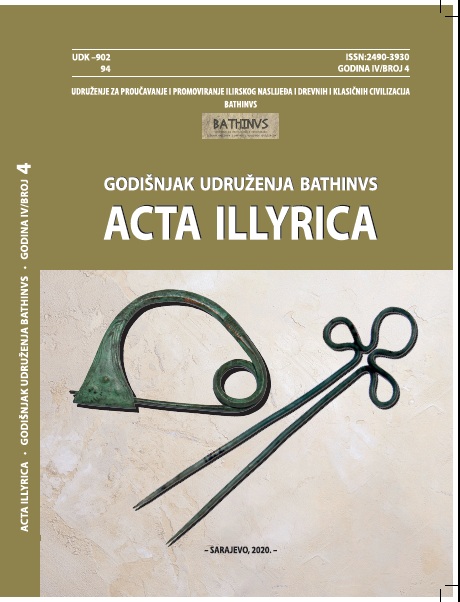Kolapijani - Apijanovi Peonci
Colapiani - Appian's Paeones
Author(s): Alka Domić KunićSubject(s): Archaeology, Cultural history, Local History / Microhistory, Ancient World
Published by: Udruženje za proučavanje i promoviranje ilirskog naslijeđa i drevnih i klasičnih civilizacija “BATHINVS”
Keywords: Colapiani;Pannonians;Segesta;Roman conquest;literary sources;
Summary/Abstract: After conquering the Iapodean center Metulum in 35 BC, Octavian (soon to be Emperor Augustus) set forth towards Segesta with his legions “through the land of the Paeonians not yet conquered by the Romans” (App. Illyr. IV, 22). Appian’s Paeonians were actually the Pannonians, and this paper aims to show that this community was also known as the Colapiani. The land of the Pannonians was located between Octavian’s two main strategic goals (Metulum and Segesta) and it’s reasonable to assume that Octavian wanted to put this land under Roman control as well. According to Appian, Octavian first hoped for a peaceful surrender, but the land of the Pannonians, in the end, had to be conquered by means of armed conflict. The territory of the Pannonians (Appian’s Paeonians) is outlined by ancient written sources and yet insufficient archaeological explorations. Octavian’s legions could have reached Segesta from Metulum following two directions: the valleys of the Mrežnica and Kupa rivers (northern direction 125 km long) or the valley of the Glina river (eastern direction 100 km long). This other direction is more probable because it’s shorter and suitable for army march. The rivers Mrežnica, Korana, and Glina belong to the basin of the Kupa river which revealed evidence of the Colapiani whose name literally means “those who live by the Kupa river.”The majority of historical resources that directly or indirectly mention Octavian’s military campaign in 35 BC (Tibullus, Ovid, Livy, Strabo) are contemporaries with the war and reflect a contemporary perception of the ethnic situation in the Pannonian Interfluve, an area between the Drava and Sava rivers. Florus and Appian are about 150 years younger, but the first authored the summary of Livy’s History, whereas the latter mostly rewrote from Octavian’s memoirs. All of these sources mention the Pannonians and the Segestani, the inhabitants of the Pannonian center of Segesta. Cassius Dio also mentions the Pannonians, but from the perspective of his own time (2nd/3rd century) when that term stands for “the inhabitants of the Roman province of Pannonia.” Pliny the Elder and Claudius Ptolemy are the only ones mentioning the Colapiani in the context ofthe already organized Roman province. The Colapiani were also mentioned on several Roman inscriptions in an entirely Roman context (as members of Roman auxiliary units). This paper aims to establish whether the Pannonian name referred to the entire Interfluve ever since the first known mention of the Pannonians by Polybius in the 2nd century BC (Polyb. frg. 64) or it extended from the western part after Octavian’s conquest. The author believes that the name Colapiani, attested in an entirely Roman context (members of one of civitates peregrinae), was locally used even before the Roman conquest and that was taken over by Rome from the indigenous population, and author’s question is how to interpret the relationship between the Pannonians and the Colapiani. One possibility is that the Pannonians mentioned by historical sources refers to some sort of military and political alliance in the Interfluve, and that the Colapiani (probably the leading community in the western part of the Interfluve) are one of these communities. It is possible that this community was named Pannonians, but that the name Colapiani was descriptive in the already mentioned context – “those by the Kupa river.”
Journal: Godišnjak Udruženja BATHINVS “Acta Illyrica”
- Issue Year: 4/2020
- Issue No: 4
- Page Range: 107-161
- Page Count: 55
- Language: Croatian

